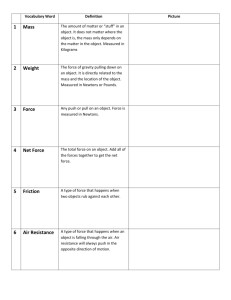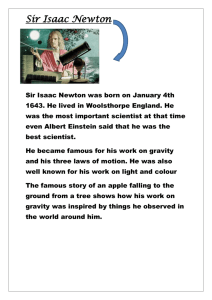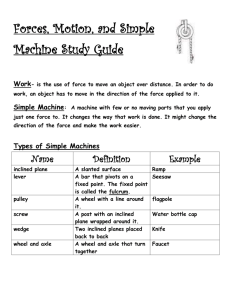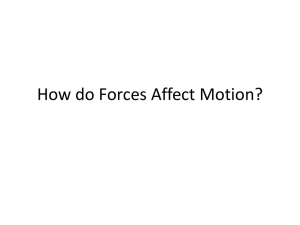Gravity and Motion PPT
advertisement
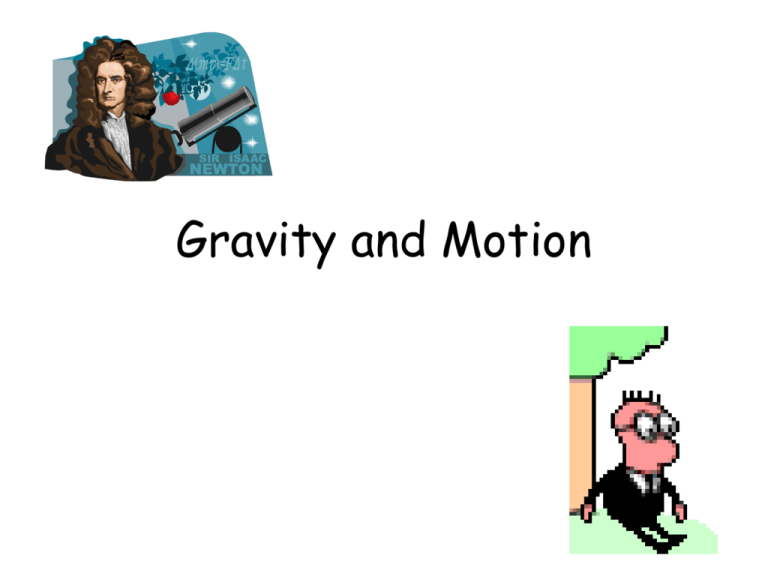
Gravity and Motion Isaac Newton • Sir Isaac Newton was one of the greatest scientists and mathematicians that ever lived. • Isaac Newton was the first person to hypothesize that the force that pulls an apple to the ground also pulls the moon toward Earth, keeping it in orbit. Force • A force is a push or a pull. • Force gives an object the energy to move, stop moving, or change direction. • When you write with a pen you exert a force. When you peddle your bike, blow your nose, turn on a faucet, chew your gum, or swimming in a pool, you are exerting forces on other objects. • We would never be able to move without exerting forces on things. Friction • Friction is a force that opposes motion. Friction acts in a direction opposite to the objects direction in motion. • Without friction, the object would continue to move at a constant speed forever. • Example: sliding friction. This is when two surfaces slide one over the other. A snowboarder slides over the snow covered slopes using sliding friction every day. Gravity • Newton was the first person to seriously study gravity • Gravity is a force that attracts all objects toward each other. • The force of gravity is measured in units called Newtons (N). • http://www.brainpop.com/ (Gravity) • http://www.unitedstreaming.com/ Basics of Physics: Exploring Gravity Clips: What is Gravity? And Mass and Weight Gravity • The strength of gravity between two objects depends on two factors: • 1. masses of the objects (If mass increases, force also increases) • 2. distance between the objects (If distance increases, force decreases) Gravity Gravity The greater the mass, the greater the force The greater the distance, the less the force Acceleration due to gravity = 9.8 m/s/s or 9.8 m/s2 Mass vs. Weight • Mass- is the amount of matter in an object • Weight- is the force of gravity on an object • The greater the mass the greater the force (weight) • Weightlessness – free from the effects of gravity Newton’s First Law of Motion • An object at rest will remain at rest unless acted on by an unbalanced force. • An object in motion continues in motion with the same speed and in the same direction unless acted upon by an unbalanced force. • This law is often called "the law of inertia". Law of Inertia • Inertia- the tendency of an object to resist a change in motion. • This law is the same reason why you should always wear your seatbelt. Crash Test With/Without Seatbelts • http://regentsprep.org/Regents/physics/phys 01/accident/nobelt.htm • http://regentsprep.org/Regents/physics/phys 01/accident/withbelt.htm Examples of the Law of Inertia • index card/penny example • magician's trick of pulling a tablecloth out from under dishes on a table. • when riding a horse, the horse suddenly stops and you fly over its head • car turns left and you appear to slide to the right • the difficulty of pushing a dead car • football player running with the ball • http://www.stevespanglerscience.com/experiment/ 00000131 Why do Earth and the moon remain in their orbits? • Inertia and gravity combine to keep Earth in orbit around the sun and the moon in orbit around the Earth. • A combination of gravity and inertia keeps the moon in orbit around the Earth. If there were no gravity, inertia would cause the moon to travel in a straight line. If only gravity existed, the earth would be pulled into the sun. Your weight on other worlds • http:/www.exploratorium.edu/ronh/weight/

